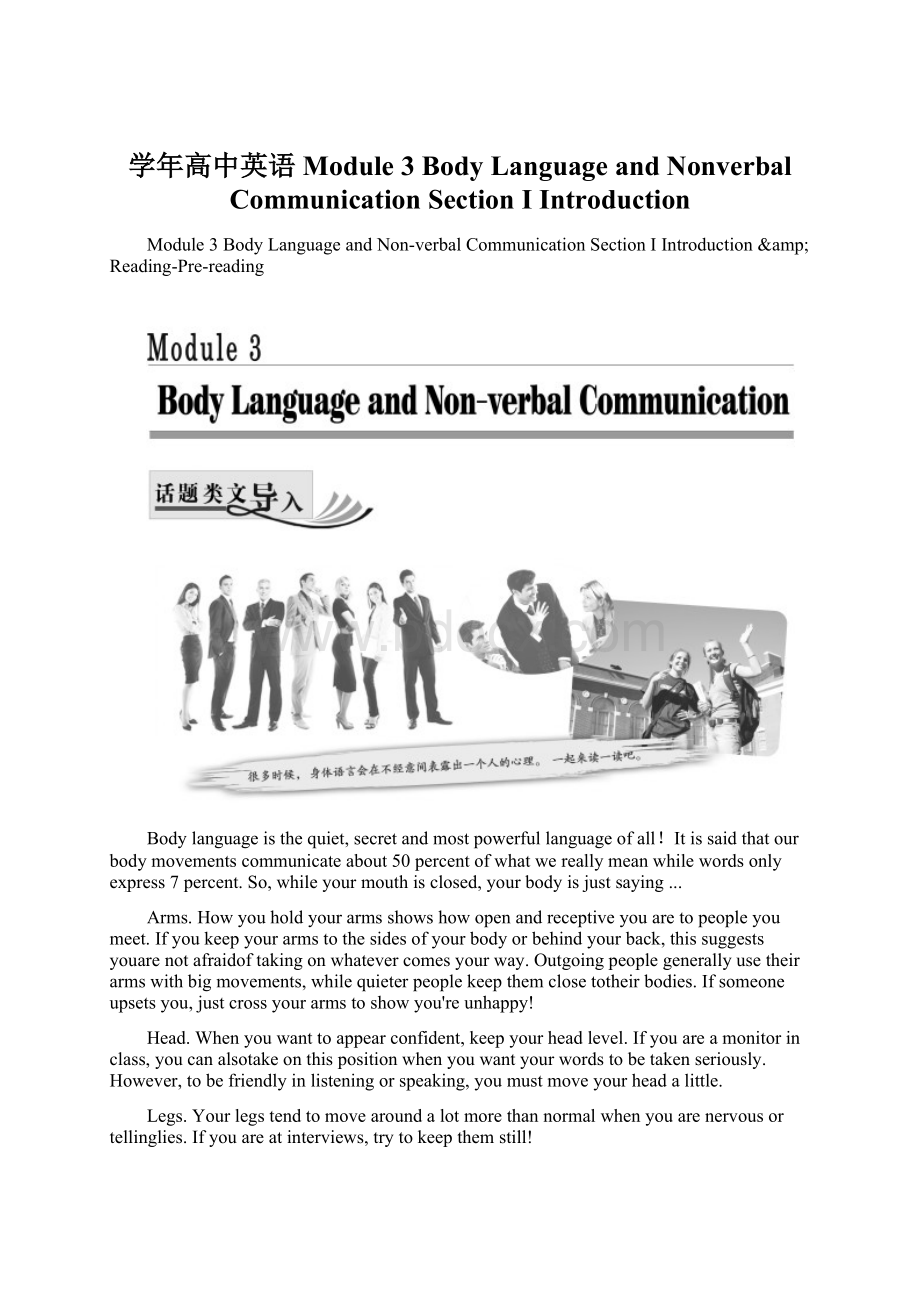 学年高中英语 Module 3 Body Language and Nonverbal Communication Section Ⅰ Introduction.docx
学年高中英语 Module 3 Body Language and Nonverbal Communication Section Ⅰ Introduction.docx
- 文档编号:3451516
- 上传时间:2022-11-23
- 格式:DOCX
- 页数:15
- 大小:155.25KB
学年高中英语 Module 3 Body Language and Nonverbal Communication Section Ⅰ Introduction.docx
《学年高中英语 Module 3 Body Language and Nonverbal Communication Section Ⅰ Introduction.docx》由会员分享,可在线阅读,更多相关《学年高中英语 Module 3 Body Language and Nonverbal Communication Section Ⅰ Introduction.docx(15页珍藏版)》请在冰豆网上搜索。

学年高中英语Module3BodyLanguageandNonverbalCommunicationSectionⅠIntroduction
Module3BodyLanguageandNon-verbalCommunicationSectionⅠIntroduction&Reading-Pre-reading
Bodylanguageisthequiet,secretandmostpowerfullanguageofall!
Itissaidthatourbodymovementscommunicateabout50percentofwhatwereallymeanwhilewordsonlyexpress7percent.So,whileyourmouthisclosed,yourbodyisjustsaying...
Arms.Howyouholdyourarmsshowshowopenandreceptiveyouaretopeopleyoumeet.Ifyoukeepyourarmstothesidesofyourbodyorbehindyourback,thissuggestsyouarenotafraidoftakingonwhatevercomesyourway.Outgoingpeoplegenerallyusetheirarmswithbigmovements,whilequieterpeoplekeepthemclosetotheirbodies.Ifsomeoneupsetsyou,justcrossyourarmstoshowyou'reunhappy!
Head.Whenyouwanttoappearconfident,keepyourheadlevel.Ifyouareamonitorinclass,youcanalsotakeonthispositionwhenyouwantyourwordstobetakenseriously.However,tobefriendlyinlisteningorspeaking,youmustmoveyourheadalittle.
Legs.Yourlegstendtomovearoundalotmorethannormalwhenyouarenervousortellinglies.Ifyouareatinterviews,trytokeepthemstill!
Posture(姿势).Agoodposturemakesyoufeelbetteraboutyourself.Ifyouarefeelingdown,younormallydon'tsitstraight,withyourshouldersinwards.Thismakesbreathingmoredifficult,whichcanmakeyoufeelnervousoruncomfortable.
Mouth.Whenyouarethinking,youoftenpurse(撅起嘴唇)yourlips.Youmightalsousethispositiontoholdbackanangrycomment(评论)youdon'twishtoshow.However,itwillprobablystillbenoticed,andpeoplewillknowyou'renotpleased.
Face.Whenyoulie,youmightputonafalseface.Butthatexpressionwouldcrack(使破裂)briefly,allowingdisplaysoftrueemotionssuchashappiness,sadness,disgust(厌恶)andfeartocomethrough.
Section_Ⅰ
Introduction&Reading—Prereading
Ifyousaytheword“communication①”,mostpeoplethinkof②wordsandsentences.Althoughtheseareveryimportant③,wecommunicatewithmorethan④justspokenandwrittenwords.Indeed,bodypositionsarepartofwhatwecall“bodylanguage⑤”.Weseeexamplesofunconscious⑥bodylanguageveryoften,yetthereisalso“learned⑦”bodylanguage,whichvaries⑧fromculturetoculture⑨.
Weuse“learned”bodylanguagewhenweareintroducedtostrangers.Likeotheranimals,weareonguard⑪untilweknowitissafetorelax⑫.Soeveryculturehasdevelopedaformal⑬waytogreetstrangers,⑭toshowthemwearenotaggressive⑮.Traditionally⑯,EuropeansandAmericansshakehands⑰.Theydothiswiththerighthand—thestrongesthandformostpeople.Ifourrighthandisbusygreeting⑱someone,itcannotbeholdingaweapon⑲.Sothegesture⑳issaying,“Itrustyou.Look,I'mnotcarryingathreateningweapon.”Ifyoushakehandswithsomeone,youshowyoutrustthem.Weshakehandswhenwemakeadeal.Itmeans,“Weagreeandwetrusteachother.”
①communication/kəˌmjuːnI'keIʃn/n.交流;沟通
②thinkof想到,记得 ③although引导让步状语从句。
④morethan此处表示“不仅仅”。
⑤what引导宾语从句。
⑥unconscious/ʌn'kɒnʃəs/adj.无意的;不知不觉的
beunconsciousof未意识到
⑦learnedadj.习得的⑧vary/'veəri/vi.变化
varyfrom...to...从……到……变化
⑨which引导非限制性定语从句,修饰“learned”bodylanguage。
beintroducedto被介绍给
introduce...tosb.把……介绍给某人
⑪onguard(保持)警惕
⑫it作形式主语,真正的主语是后面的torelax。
⑬formal/'fɔːml/adj.正式的
⑭动词不定式短语作目的状语;wearenotaggressive是省略that的宾语从句,作show的直接宾语。
⑮aggressive/ə'ɡresIv/adj.攻击的;挑斗的;挑衅的
⑯traditionally/trə'dIʃnli/adv.传统地
⑰shakehands握手 ⑱bebusy(in)doingsth.忙于做某事
⑲weapon/'wepən/n.武器 ⑳gesture/'dʒestʃə/n.姿势;姿态
threatening/'θretnIŋ/adj.恐吓的;具有威胁的
if引导条件状语从句。
deal/diːl/协议;交易 makeadeal达成协议;做成交易
[第1~2段译文]
说起“交流”这个词,大多数人会想到词语和句子。
尽管这些很重要,但是我们并不只是通过口头和书面语言交流。
实际上,身体的姿态是我们所称的“身体语言”的一部分。
我们经常看到无意识的身体语言的例子,但也有“习得的”身体语言,“习得的”身体语言在不同的文化中各不相同。
当我们被介绍给陌生人时,我们使用“习得的”身体语言。
和别的动物一样,除非我们感觉到很安全才会放松,否则将一直处于戒备状态。
所以,每一种文化都形成了一种正规的方式来问候陌生人,以向他们表明我们并没有敌意。
欧美人的传统是握手。
他们握右手——右手对大多数人来说最有力。
如果我们的右手忙着和人打招呼,就不可能握有武器了。
因此,这种手势的意思是:
“我信任你。
瞧,我没带威胁性的武器。
”假如你和别人握手,就表明你信任他们。
当我们达成协议时,我们握手。
意思就是:
“我们达成了协议,相互信任。
”
GreetingsinAsiancountriesdonotinvolvetouchingtheotherperson,buttheyalwaysinvolvethehands.TraditionallyinChina,whenwegreetsomeone,weputtherighthandovertheleftandbowslightly.Muslimsgivea“salaam”,wheretheytouchtheirheart,mouthandforehead.Hindusjointheirhandsandbowtheirheadsinrespect.Inalloftheseexamples,thehandsarebusywiththegreetingandcannotholdaweapon.
Eventoday,whensomepeoplehaveveryinformalstylesofgreeting,theystillusetheirhandsasagestureoftrust.Americanyouthsoftengreeteachotherwiththeexpression,“Givemefive!
”Onepersonthenholdsuphishand,palmoutwardsandfivefingersspread.Theotherpersonraiseshishandandslapstheother'sopenhandabovetheheadina“highfive”.Nowadays,itisquiteacommongreeting.
Bodylanguageisfascinatingforanyonetostudy.Peoplegiveawaymuchmorebytheirgesturesthanbytheirwords.Lookatyourfriendsandfamilyandseeifyouareamindreader!
involve/In'vɒlv/vt.包括 involvedoingsth.包括做某事
put...over...把……放在……上
bow/baʊ/vi.鞠躬bowtosb.向某人鞠躬
slightly/'slaItli/adv.轻微地;稍微
Muslim/'mʊzləm/n.(常作复数)穆斯林
salaam/sə'lɑːm/n.(穆斯林的)额手礼
forehead/'fɒrId/n.前额
where引导非限制性定语从句,修饰先行词a“salaam”。
Hindu/'hInduː/n.印度人jointheirhands双手交叉
inrespect=respectfully尊敬地 bebusywithsth.忙于某事
informal/In'fɔːml/adj.非正式的
when引导时间状语从句。
use...as...把……用作youth/juːθ/n.年轻人
holdup举起 反义词组:
putdown
palm/pɑːm/n.手掌spread/spred/vi.(spread,spread)张开
slap/slæp/vt.掌击
quite修饰名词时,常把冠词a(n)置于其后。
bodylanguage身体语言,身势语
fascinatingadj.有极大吸引力的;迷人的
fascinatedadj.被迷住的,被吸引的;极感兴趣的(不用于名词前)
giveaway暴露(自己的情况)
if引导宾语从句,作see的宾语。
mindreader/'maIndˌriːdə/n.(自称或被认为)能看透别人心思的人
[第3~5段译文]
亚洲国家的问候并不包括触摸别人,但总是有手的接触。
与人打招呼时,中国人的传统方式是将右手放在左手上,稍稍躬身而行礼。
穆斯林行“额手礼”,用手触心、嘴和前额。
印度人双手交合,恭敬地行合十礼。
在上述例子中,手都在忙于打招呼,不可能拿武器。
即使是现在,有些人在非正式场合打招呼时,还会用手来表示信任对方。
美国年轻人常常会用“来击个掌吧!
”的表达打招呼。
然后一个人举起手,手掌向外,五指展开。
另一个人同样举起手,拍打对方举过头顶的手。
现在,它是一种很常见的打招呼方式。
身体语言对任何研究者来说都具有吸引力。
人们通过姿势传达的信息要比通过话语传达的多得多。
看看你的朋友和家人,试试你能否读懂他们的心事!
Prereading
Pleasematchthewordswiththeirpropermeanings.
1.communicate A.adv.传统地
2.unconsciousB.adj.攻击的;挑斗的;挑衅的
3.varyC.vi.(用语言、信号)传递信息;交流
4.formalD.adj.无意的,不知不觉的
5.aggressiveE.vi.变化
6.traditionallyF.vi.鞠躬
7.gestureG.adj.正式的
8.threateningH.vi.张开
9.dealI.adv.轻微地;稍微
10.involveJ.adj.恐吓的;具有威胁的
11.slightlyK.n.姿势;姿态
12.bowL.vt.包括
13.youthM.n.协议,交易
14.spreadN.n.年轻人
答案:
1~5 CDEGB 6~10 AKJML 11~14 IFNH
Leadin
Inourlife,weoftenusebodylanguage,itisawayofourcommunication.Canyouguessthemeaningsofthesehandgestures?
A.waveB.a“highfive” C.OK D.love E.thumbsup
F.clap G.shake H.shrugone'sshoulder
答案:
①~⑤ FGEAB ⑥~⑧ HDC
Whilereading
Fastreading
(Ⅰ)Skimthetextandmatchthemainideawitheachparagraph.
1.Para.1 A.greetingsinAsiancountries
2.Para.2B.waysofcommunication
3.Para.3C.fascinatingbodylanguage
4.Para.4D.greetingsinwesterncountries
5.Para.5E.Americanyouths'greetingtoday
答案:
1~5 BDAEC
(Ⅱ)True(T)orFalse(F).
1.BodyLanguagevariesfromculturetoculture.__T__
2.Europeansshakehandswiththeirrighthandwhengreeting.__T__
3.InAsiancountriesgreetinginvolvestouchingeachother.__F__
4.Muslimsgreetbyjoiningtheirhandsandbowingtheirheads.__F__
5.Peoplecangiveawaymorebygesturesthanbywords.__T__
Carefulreading
(Ⅰ)Readthetextcarefullyandchoosethebestanswers.
1.Whatdoestheword“communication”meaninthepassage?
A.Wordsandsentences.
B.Unconsciousbodylanguage.
C.“Learned”bodylanguage.
D.Alloftheabove.
2.“Shakinghands”meansallthefollowingEXCEPT“________”.
A.weagreeandwetrusteachother
B.wearenotaggressive
C.werespecteachother
D.ourrighthandsarestrongest
3.WhichofthefollowingstatementsisNOTtrue?
A.Givinga“salaam”isakindof“learned”bodylanguage.
B.A“highfive”isaformalstyleofgreeting.
C.Whenwemakeadealweshakehands.
D.InAsia,touchingeachotherwhentheymeetisn'tacommongreeting.
4.Whichofthefollowingistheclosestinmeaningtothephrase“giveaway”inthelastparagraph?
A.Givesb.sth.forfree. B.Throwaway.
C.Giveup.D.Makesth.knowntosb.
5.Accordingtothetext,ifyouwanttobeamindreader,whatwillyoudo?
A.Toknowmorecultures.
B.Learnmorebodylanguage.
C.Learntosmile.
D.Communicatewithothersbywords.
答案:
1~5 DDBDB
(Ⅱ)Readthetextagainandfillinthechartwiththeinformationinthetext.
People
1.Ways_of_greeting
Traditional
Europeans
andAmericans
2.Shake_handswiththerighthandtoshowyoucanbe3.trusted.
4.Ancient_Chinese
Puttherighthandovertheleftand
5.bow_slightly.
6.Muslims
Givea“salaam”,wherethey7.touch_their_heart,_mouthandforehead.
Hindus
Joinhandsandbowheads8.in_respect.
9.American
youths
“Givemefive!
”
Theconclusion
Bodylanguageisimportantandfascinatingandweshouldtrytobea10.mind_reader.
Studyreading
Analyzethefollowingdifficultsentencesinthetext.
1.Indeed,bodypositionsarepartofwhatwecall“bodylanguage”.
[句式分析] 句中what引导的宾语从句作of的宾语,what在从句中作call的宾语。
[尝试翻译] 实际上,身体的姿势是我们所称的“身体语言”的一部分。
2.Weseeexamplesofunconsciousbodylanguageveryoften,yetthereisalso“learned”bodylanguage,whichvariesfromculturetoculture.
[句式分析]
[尝试翻译] 我们经常看到无意识的身体语言的例子,但也有“习得”的身体语言,“习得的”身体语言在不同的文化中各不相同。
3.Muslimsgivea“salaam”,wheretheytouchtheirheart,mouthandforehead.
[句式分析] where引导非限制性定语从句,修饰salaam,where在定语从句中作状语。
[尝试翻译] 穆斯林行“额手礼”,用手触心、嘴和前额。
4.Onepersonthenholdsuphishand,palmoutwardsandfivefingersspread.
[句式分析] palmoutwardsandfivefingersspread为独立主格结构“名词+副词/过去分词”,作伴随状语。
[尝试翻译] 然后一个人举起手,掌
- 配套讲稿:
如PPT文件的首页显示word图标,表示该PPT已包含配套word讲稿。双击word图标可打开word文档。
- 特殊限制:
部分文档作品中含有的国旗、国徽等图片,仅作为作品整体效果示例展示,禁止商用。设计者仅对作品中独创性部分享有著作权。
- 关 键 词:
- 学年高中英语 Module Body Language and Nonverbal Communication Section Introduction 学年 高中英语
 冰豆网所有资源均是用户自行上传分享,仅供网友学习交流,未经上传用户书面授权,请勿作他用。
冰豆网所有资源均是用户自行上传分享,仅供网友学习交流,未经上传用户书面授权,请勿作他用。
链接地址:https://www.bdocx.com/doc/3451516.html


 转基因粮食的危害资料摘编Word下载.docx
转基因粮食的危害资料摘编Word下载.docx
